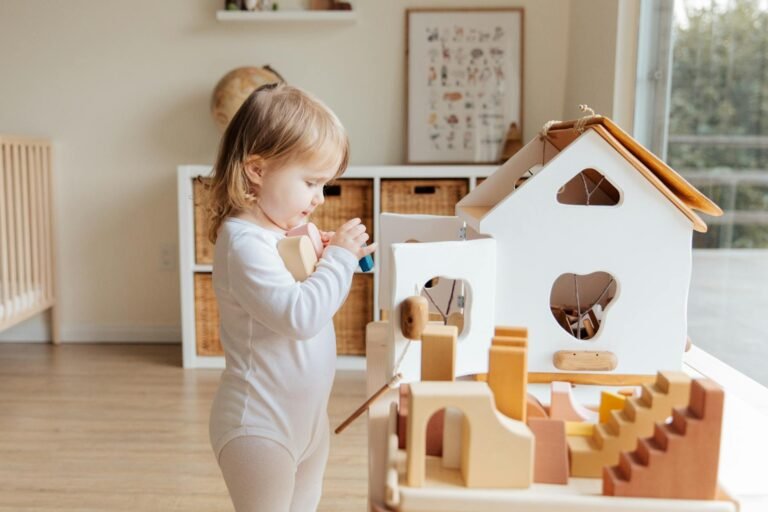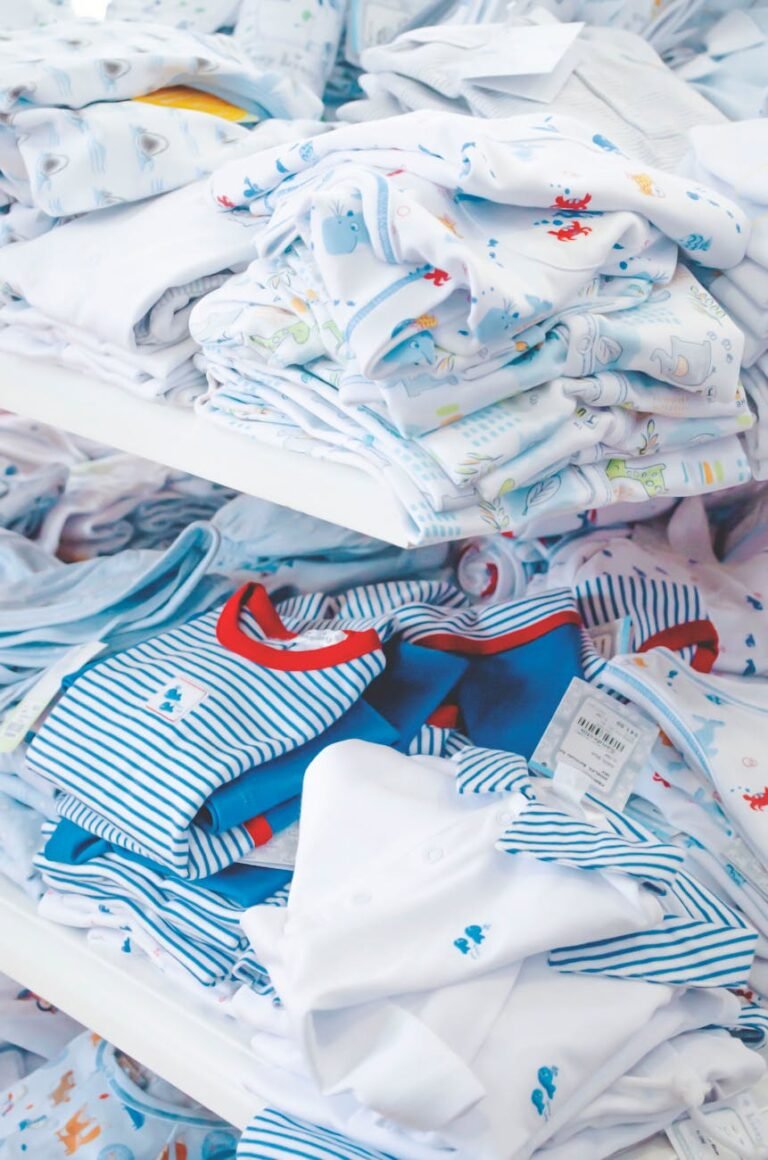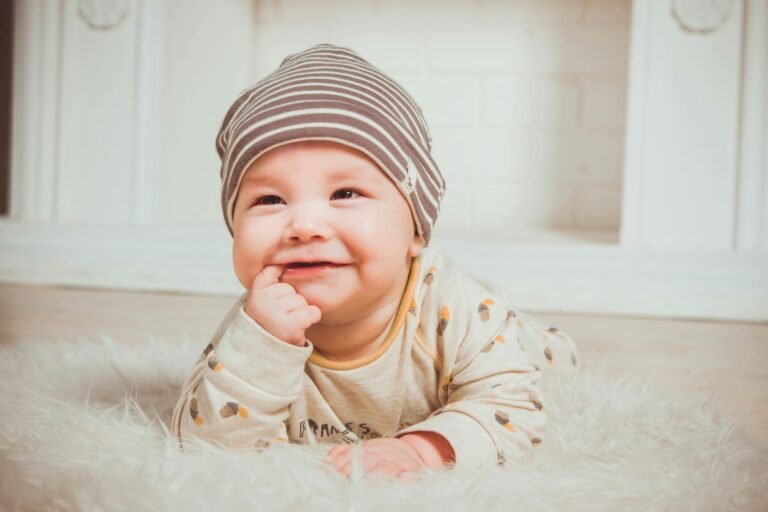Ever thought about how long your newborn will wear those cute outfits? Knowing the newborn clothing duration helps parents shop better. Babies grow fast, so they outgrow clothes quickly. This means they usually wear outfits for just three to six weeks.
Babies who weigh eight pounds or less at birth wear newborn sizes for 3 to 5 weeks. But, if they weigh more, they might outgrow them sooner. It’s smart to have at least 15 Onesies® Brand Bodysuits and 7 sleepers. This is because babies might need two outfits a day and one for sleep.
Also, remember that baby clothes lifespan changes with brands. If your baby grows fast, you’ll need to buy new clothes often. But, if they grow slower, they might stay in newborn-size clothes longer.
Key Takeaways
- Newborns grow quickly, usually fitting into newborn sizes for only three to six weeks.
- Having approximately 15 Onesies® Brand Bodysuits and 7 sleepers is recommended for the first month.
- Parents should be prepared to update their baby’s wardrobe frequently due to rapid growth.
- Different brands have varying newborn clothing duration, affecting fit and comfort.
- Purchasing essential clothing ahead can help manage expenses and ensure baby’s comfort.
Understanding Newborn Sizes
When dressing your little one, it’s key to understand the newborn size guide. There’s no one size fits all, leading to big newborn brand size differences.
Size Variations
Newborn sizes fit babies weighing 5-8 pounds and up to 21.5 inches long. Moving to 0-3 month sizes, outfits fit 8-12 pound babies. It’s interesting to see how baby clothing size comparison shows sizes change a lot early on. For example:
- 0-3 month sizes: 8-12 pounds, average length 19-24 inches
- 3-6 month sizes: 12-17 pounds, length 23-27 inches
- 6-9 month sizes: 17-21 pounds, length 26-28 inches
- 9-12 month sizes: 21-25 pounds, length 27-30 inches
Comparing Different Brands
Brands have their own ways of fitting clothes, leading to newborn brand size differences. Comparing sizes across brands helps pick the right fit:
| Brand | Size Range | Weight Range | Length Range |
|---|---|---|---|
| Baby Gap | 3-6 months | 12-17 pounds | 23-27 inches |
| Carter’s | 3 months | 9-12.5 pounds | 21.5-24 inches |
| Gerber | Newborn | 5-8 pounds | 17-21 inches |
| Old Navy | 0-3 months | 7-12 pounds | 19-23 inches |
| Target | Newborn | 6-8 pounds | 18-20 inches |
With so many newborn brand size differences, it’s wise to buy a few sizes up when unsure. A detailed newborn size guide ensures your baby’s clothes fit well as they grow.
How Long Do Babies Stay in Newborn Clothes
Knowing how long newborn clothes last helps parents plan. Newborn clothes usually fit for three to six weeks. But, it can vary.
Newborns grow fast, gaining 1 ounce daily and ½ to 1 inch monthly. This quick growth means they outgrow their clothes quickly. Babies under 8 pounds at birth wear newborn clothes for 3 to 5 weeks. The average birth weight is about 7.5 pounds.

It’s key to find the right balance in clothing. Experts suggest having 15 Onesies® Brand Bodysuits and 7 sleepers. This allows for enough outfits for the day and night.
Also, include a few pairs of pants for cold months. Moving to 0-3 months and 3-6 months sizes is a good idea. These sizes last longer and are more versatile.
Watching your baby’s growth is more important than age guidelines. For example, bigger babies might outgrow newborn clothes faster. Smaller babies might stay in them longer.
Newborn clothes are for babies up to 8 pounds. But, each baby grows at their own pace. Keeping an eye on their growth helps us plan for a smooth transition.
Essential Newborn Wardrobe
Creating a practical wardrobe for your baby is key. You’ll need basic clothes and must-haves for comfort and quick changes. Here’s what new parents should know:
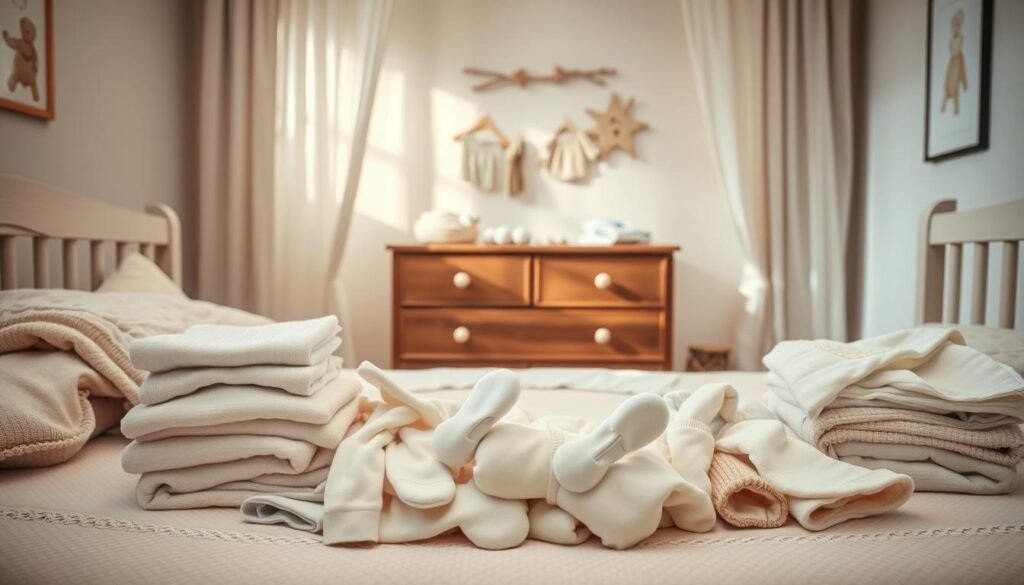
Start with 6 to 8 bodysuits or Onesies® Brand Bodysuits. They’re comfy and easy to change. Newborns grow fast, so have plenty of outfits ready.
Also, get 3 to 4 pairs of pants or leggings. They’re versatile and keep your baby warm. Make sure to have sizes like 0-3M and 3-6M.
For sleep, get 4 to 5 pairs of pajamas or sleepers. They keep your baby cozy at night. The ideal sleeping temperature is 68 to 72 degrees Fahrenheit.
Don’t forget special outfits for memorable moments. Have 1 to 3 for these occasions. Also, get 5 to 6 pairs of socks and 2 to 3 hats to keep your baby warm.
Remember, your baby’s size changes often. They might wear newborn sizes for only 3 to 5 weeks if they’re eight pounds or less. Do small laundry loads and use baby-friendly detergent. Air drying or low-heat drying helps keep clothes in good shape.
Choosing the Best Fabrics for Your Baby
Choosing the right fabrics for newborns is key for their comfort and safety. Let’s look at the top materials and their benefits.
Benefits of Cotton
Cotton is a top pick for baby clothes. It’s soft, breathable, and safe for sensitive skin. Organic cotton is chemical-free and fades less than treated cotton.
- Softness and Comfort – Cotton’s natural fibers provide a cozy and comfortable fit for delicate skin.
- Breathability – The fabric allows air circulation, preventing overheating.
- Hypoallergenic – Ideal for babies with sensitive skin or allergies.
Importance of Fire Hazard Labels
It’s crucial to pick clothes that are safe from fires. Look for low fire hazard labels. These show the clothes meet safety standards. Synthetic fabrics like polyester are less safe because they’re not as breathable.
- Fire-Resistant Materials – Choose fabrics designed to reduce fire risks.
- Verified Certifications – Ensure all baby clothes comply with safety standards.
Risks of Loose Trimmings
It’s also important to avoid clothes with loose trimmings. Loose beads, threads, or decorations can be dangerous. They can cause choking or strangulation.
- Choking Hazard – Loose trims can easily be pulled off and swallowed by curious little ones.
- Strangulation Risk – Avoid strings or threads that could wrap around a baby’s fingers, limbs, or neck.
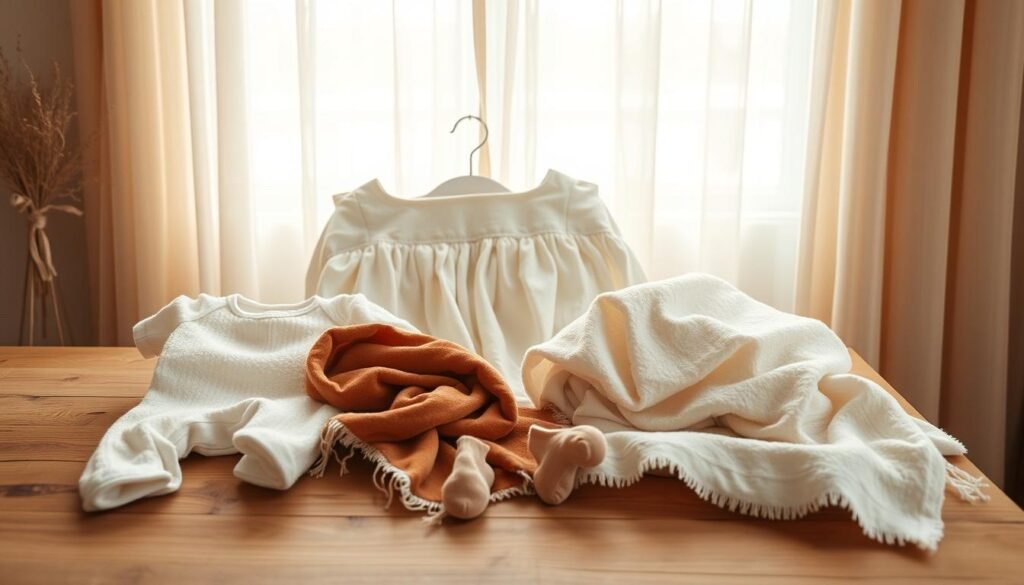
When picking fabrics, consider their price and practicality. Here’s a look at some popular baby sleep bags.
| Product | Material | Price | Key Features |
|---|---|---|---|
| Ecolino® Adjustable Baby Sleep Bag | 100% Organic Cotton | $49.00 | Hypoallergenic, Machine-washable |
| 4 Season® Basic Baby Sleeping Bag | Merino Wool | $79.00 | Temperature Regulation, Hypoallergenic |
| 4 Season® Ultimate Baby Sleep Bag | Merino Wool | $109.00 | Temperature Regulation, Low Washing Frequency |
| 4 Season® Baby Sleep Bag with Feet | Merino Wool | $129.00 | Self-Cleaning Properties, Versatile Design |
Dressing Your Newborn for Weather Conditions
Choosing the right clothes for your newborn is key for their comfort and safety. It’s important to keep their body temperature between 98 to 100 degrees Fahrenheit. Understanding how babies regulate heat helps you dress them right.
In cold weather, layering is essential. Start with a thin sleeper onesie and add more layers like a long-sleeved shirt and pants. Remember, dress your baby in one more layer than you are. This keeps them warm, even when it’s cold outside.
When it’s hot, a single layer of light clothes is enough. Choose cotton because it’s breathable and soft. Try to keep your baby out of direct sunlight, as they can’t protect themselves well.
Babies can get too hot, which is risky. Watch for signs like flushed skin and fast breathing. Keeping the room between 68 to 72 degrees Fahrenheit helps keep them comfortable.
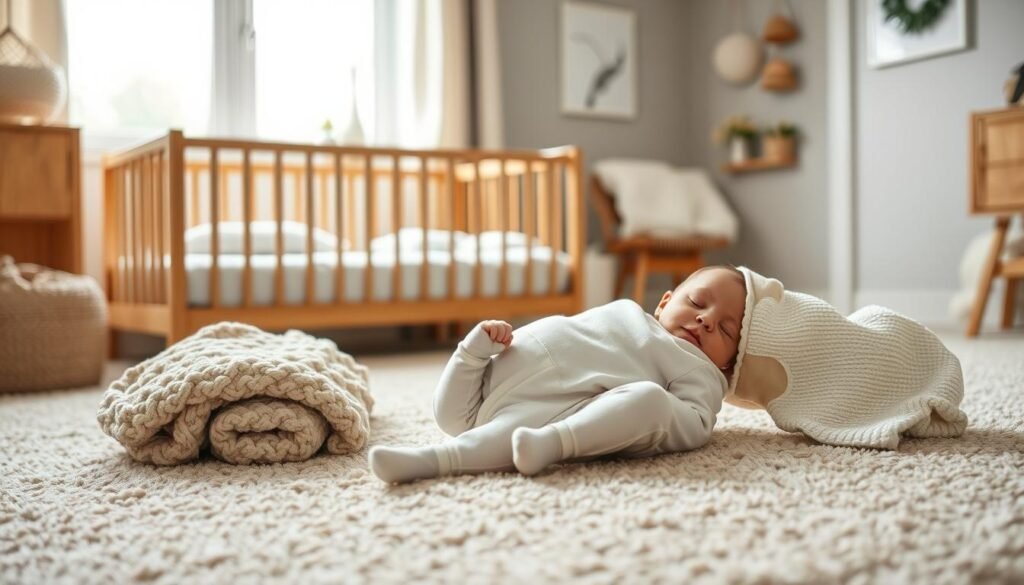
At night, dress your baby lightly. A thin vest or just a nappy is fine on warm nights. Don’t use heavy blankets. By following these tips, we can keep our babies safe and cozy in any weather.
How to Properly Dress and Undress a Newborn
Learning how to dress a newborn might seem hard at first. But, with some simple steps, it gets easier. We aim to make dressing your baby smooth and comfy for them.
Step-by-Step Guide
Here’s a detailed guide to make dressing and undressing your baby easy:
- Preparation: Have all clothes ready and the room warm. A cozy room helps calm babies during clothing changes.
- Support and Safety: Always hold your baby with one hand to stop them from rolling.
- Clothing Orientation: Place the garment flat with the collar open. Smooth it out to avoid wrinkles.
- Head First: Carefully pull the clothing over your baby’s head. Make sure it doesn’t rub their face. Stretch the neckholes to avoid face contact.
- Arms and Legs: Put your hand through the sleeve or leg opening. Hold your baby’s hand or foot and pull through gently. Don’t twist their limbs.
- This method is great for efficient dress techniques for infants as it reduces resistance.
- Adjust and Smooth: Make sure the garment fits well. Avoid any folds or pressure points on the skin.
Tips to Calm Your Baby During Dress Changes
Keeping a newborn calm during dressing can be tough but important. Here are some helpful tips:
- Warm Environment: A warm room makes your baby feel safe and less cranky.
- Soft Talking: Talk softly, sing, or use reassuring words to comfort your baby.
- Gentle Movements: Move slowly and carefully to avoid startling your baby.
- Distractions: Use a favorite toy or a mobile to distract them.
These tips are great for calming babies during clothing changes. They help make the experience better for both you and your baby. Remember, being consistent and patient is key to mastering how to dress a newborn.
Shopping Tips: When and What to Buy
Buying clothes for a newborn can be tough because they grow fast. But, with some planning, you can be ready without buying too much. Here are some key tips for shopping for newborns.
Planning Ahead for Growth Spurts
Newborns grow quickly, often outgrowing clothes in weeks. It’s important to plan for these growth spurts. Here’s what we suggest:
- Buy 4 to 6 bodysuits, 4 to 6 one-pieces, and 4 to 6 T-shirts.
- If your baby is over 7 pounds at birth, get some 0-3 month clothes.
- Get 3 to 4 fitted crib sheets and a dozen burp cloths for messes.
- Buy a digital baby thermometer and diapers for health and comfort.
- Get slightly larger sizes for sudden growth spurts and longer wear.
“Newborns typically outgrow their clothes within the first few weeks. Investing in the next size up can save you from frequent shopping trips.”
Features to Look for in Newborn Clothes
Not all newborn clothes are the same. Knowing the important features in newborn clothing can make a big difference. Here are some features we recommend:
- Adjustable closures: Look for snap buttons or stretchy necklines for easy dressing.
- Stretchable fabrics: Cotton blends are soft, stretchy, and good for movement and growth.
- Easy-care properties: Choose machine-washable fabrics that last through many washes.
- Durability: Reinforced knees and strong stitching make clothes last longer.
- Comfort and safety: Avoid clothes with loose trimmings or buttons that could be a choking hazard.
| Item | Quantity |
|---|---|
| Bodysuits | 4 to 6 |
| One-pieces | 4 to 6 |
| T-shirts | 4 to 6 |
| Burp Cloths | 12 |
| Fitted Crib Sheets | 3 to 4 |
By following these tips and focusing on growth, your baby will stay comfy and stylish. This lets you enjoy those early moments together more.
Managing Newborn Clothing Laundry
Laundering newborn clothes is key for parents. It keeps clothes clean, safe, and free from irritants. Knowing the best ways can make this task easy and keep your baby’s clothes in top shape.
Importance of Pre-Washing
Pre-washing baby clothes is vital. It removes chemicals from the making process. These can be tough on a baby’s sensitive skin. Pre-washing makes sure clothes are clean and safe for your little one.
Best Detergents for Sensitive Skin
Choosing the right detergent for baby clothes is important. Look for ones made for sensitive skin. All Free Clear or Dreft are good picks. They clean well without being harsh on delicate skin.
Handling Stains and Messes
Babies often get spills and stains. Knowing how to remove stains is key. Use a baby-safe stain remover before washing. Also, wash in cold water on a gentle cycle to avoid damage.
Following these tips makes laundry for newborns easy. It keeps their clothes fresh and comfy. A regular laundry routine is important for your baby’s skin and clothes.
Conclusion
Our guide covers key points about managing your newborn’s clothes. It talks about sizes and the best fabrics. Newborn clothes fit babies up to 8 pounds and 21.5 inches. They grow out of these clothes fast, in about 2 to 3 weeks.
It’s important to be ready for growth spurts. You should get clothes for the 0-3 months range. This helps your baby stay comfortable and stylish.
We suggest choosing clothes made from quality fabrics like cotton. This keeps your baby comfortable and safe. Remember, babies grow fast, so they don’t wear newborn clothes for long.
By the time they are 5 months old, many babies have doubled their birth weight. They quickly move through different sizes. This means you’ll need to buy clothes in different sizes soon.
Good wardrobe management includes pre-washing clothes and using gentle detergents. It also means handling stains quickly. These tips help keep your baby dressed, comfortable, and safe.
By following our guide, you’ll be ready for your baby’s early months. You’ll feel confident and prepared. Enjoy this special time with your little one!
FAQ
How long do babies typically wear newborn-sized clothing?
Babies usually wear newborn clothes for three to six weeks. But, growth rates can vary a lot.
What are the common size classifications for newborn clothes?
Size 000 fits babies from 0-3 months. Size 00 is for 3-6 months. Sizes can change a lot between brands.
How do I compare newborn sizes among different brands?
It’s best to compare clothes by looking at them, not just size labels. Sizes can be different between brands.
What essential items should I include in a newborn’s wardrobe?
You’ll need six singlets, jumpsuits, and a few pairs of socks. Also, include jackets and hats for different weather. This keeps your baby’s wardrobe simple and versatile.
Why is cotton the preferred fabric for newborn clothes?
Cotton is soft, breathable, and safe for baby’s skin. It keeps babies comfy and prevents skin problems.
What is the importance of low fire hazard labels on baby clothes?
Low fire hazard labels mean the clothes are safer. They reduce the risk of fires.
Why should I avoid newborn clothes with loose trimmings?
Clothes with loose trimmings, like beads, can be dangerous. They can cause choking or strangulation. It’s safer to choose clothes without these.
How should I dress my newborn for different weather conditions?
Dress your baby in layers for the weather. Use hats and blankets, but avoid too much heat. This helps prevent SIDS.
What is the best way to dress and undress a newborn?
Stretch clothes to avoid face contact. Keep the room warm. Talk softly and move gently while changing your baby.
How can I plan ahead for my baby’s growth spurts?
Buy clothes with adjustable closures and stretchy fabrics. Look for easy-care items. This helps them grow with your baby.
What are the best features to look for in newborn clothes?
Choose clothes with adjustable closures and soft, stretchy fabrics. Also, look for easy-care items. This ensures comfort and longevity.
Why is pre-washing newborn clothes important?
Pre-washing removes chemicals and irritants. This makes clothes safe and clean for your baby’s skin.
What types of detergents are best for newborn clothes?
Use baby-safe detergents without harsh chemicals or fragrances. These can irritate your baby’s skin.
How do I handle common stains and messes on newborn clothes?
Use gentle, baby-safe stain removers. Wash clothes often to keep them clean and hygienic.


